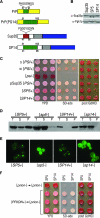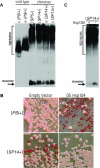Prion protein repeat expansion results in increased aggregation and reveals phenotypic variability
- PMID: 17548473
- PMCID: PMC1952097
- DOI: 10.1128/MCB.02127-06
Prion protein repeat expansion results in increased aggregation and reveals phenotypic variability
Abstract
Mammalian prion diseases are fatal neurodegenerative disorders dependent on the prion protein PrP. Expansion of the oligopeptide repeats (ORE) found in PrP is associated with inherited prion diseases. Patients with ORE frequently harbor PrP aggregates, but other factors may contribute to pathology, as they often present with unexplained phenotypic variability. We created chimeric yeast-mammalian prion proteins to examine the influence of the PrP ORE on prion properties in yeast. Remarkably, all chimeric proteins maintained prion characteristics. The largest repeat expansion chimera displayed a higher propensity to maintain a self-propagating aggregated state. Strikingly, the repeat expansion conferred increased conformational flexibility, as observed by enhanced phenotypic variation. Furthermore, the repeat expansion chimera displayed an increased rate of prion conversion, but only in the presence of another aggregate, the [RNQ+] prion. We suggest that the PrP ORE increases the conformational flexibility of the prion protein, thereby enhancing the formation of multiple distinct aggregate structures and allowing more frequent prion conversion. Both of these characteristics may contribute to the phenotypic variability associated with PrP repeat expansion diseases.
Figures





Similar articles
-
The role of pre-existing aggregates in Hsp104-dependent polyglutamine aggregate formation and epigenetic change of yeast prions.Genes Cells. 2004 Aug;9(8):685-96. doi: 10.1111/j.1356-9597.2004.00759.x. Genes Cells. 2004. PMID: 15298677
-
Prion protein/protein interactions: fusion with yeast Sup35p-NM modulates cytosolic PrP aggregation in mammalian cells.FASEB J. 2008 Mar;22(3):762-73. doi: 10.1096/fj.07-8733com. Epub 2007 Oct 10. FASEB J. 2008. PMID: 17928365
-
[PSI+] maintenance is dependent on the composition, not primary sequence, of the oligopeptide repeat domain.PLoS One. 2011;6(7):e21953. doi: 10.1371/journal.pone.0021953. Epub 2011 Jul 8. PLoS One. 2011. PMID: 21760933 Free PMC article.
-
Insights into intragenic and extragenic effectors of prion propagation using chimeric prion proteins.Prion. 2008 Apr-Jun;2(2):45-7. doi: 10.4161/pri.2.2.6509. Epub 2008 Apr 17. Prion. 2008. PMID: 19098443 Free PMC article. Review.
-
[New aspects of research upon the yeast Saccharomyces cerevisiae [PSI+] prion].Postepy Biochem. 2007;53(2):182-7. Postepy Biochem. 2007. PMID: 17969880 Review. Polish.
Cited by
-
Phylogeny and Molecular Characterisation of PRNP in Red-Tailed Phascogale (Phascogale calura).Brain Sci. 2025 Feb 26;15(3):250. doi: 10.3390/brainsci15030250. Brain Sci. 2025. PMID: 40149772 Free PMC article.
-
Epigenetic principles and mechanisms underlying nervous system functions in health and disease.Prog Neurobiol. 2008 Dec 11;86(4):305-41. doi: 10.1016/j.pneurobio.2008.10.001. Epub 2008 Oct 17. Prog Neurobiol. 2008. PMID: 18940229 Free PMC article. Review.
-
Defining the role of the polyasparagine repeat domain of the S. cerevisiae transcription factor Azf1p.PLoS One. 2021 May 21;16(5):e0247285. doi: 10.1371/journal.pone.0247285. eCollection 2021. PLoS One. 2021. PMID: 34019539 Free PMC article.
-
Prion formation by a yeast GLFG nucleoporin.Prion. 2012 Sep-Oct;6(4):391-9. doi: 10.4161/pri.20199. Epub 2012 May 7. Prion. 2012. PMID: 22561191 Free PMC article.
-
The spontaneous appearance rate of the yeast prion [PSI+] and its implications for the evolution of the evolvability properties of the [PSI+] system.Genetics. 2010 Feb;184(2):393-400. doi: 10.1534/genetics.109.110213. Epub 2009 Nov 16. Genetics. 2010. PMID: 19917766 Free PMC article.
References
-
- Bagriantsev, S., and S. W. Liebman. 2004. Specificity of prion assembly in vivo. J. Biol. Chem. 279:51042-51048. - PubMed
-
- Bessen, R. A., D. A. Kocisko, G. J. Raymond, S. Nandan, P. T. Lansbury, and B. Caughey. 1995. Non-genetic propagation of strain-specific properties of scrapie prion protein. Nature 375:698-700. - PubMed
-
- Bessen, R. A., and R. F. Marsh. 1992. Identification of two biologically distinct strains of transmissible mink encephalopathy in hamsters. J. Gen. Virol. 73(Pt. 2):329-334. - PubMed
-
- Borchsenius, A. S., S. Muller, G. P. Newnam, S. G. Inge-Vechtomov, and Y. O. Chernoff. 2006. Prion variant maintained only at high levels of the Hsp104 disaggregase. Curr. Genet. 49:21-29. - PubMed
Publication types
MeSH terms
Substances
Grants and funding
LinkOut - more resources
Full Text Sources
Other Literature Sources
Research Materials
